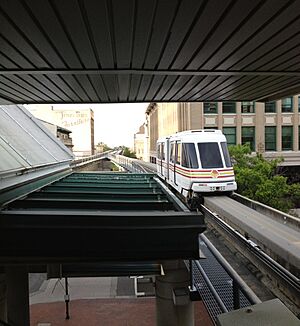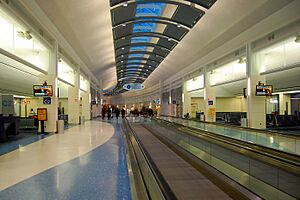Transportation in Jacksonville, Florida facts for kids
Jacksonville has a big transportation network. It helps people and goods move around by land, air, and sea. The Jacksonville Port Authority (Jaxport) runs the Port of Jacksonville, which has large shipping areas like Blount Island and Talleyrand. The Jacksonville Aviation Authority manages Jacksonville International Airport and other smaller airports.
The Jacksonville Transportation Authority (JTA) operates buses, a special overhead train called the Skyway, and park-n-ride services. The main bus hub is the Rosa Parks Transit Station. You can also find intercity bus companies and Amtrak trains for travel to other cities. Major highways like I-95 and I-10 cross through the city. I-295 forms a loop around Jacksonville.
Along with buses, JTA also runs the Skyway. This is an automated people mover system in Downtown Jacksonville. It has two lines and eight stations. These connect the Northbank, Southbank, and Lavilla areas. JTA is working to extend the Skyway into the Brooklyn neighborhood.
Jacksonville is a very spread-out city. This makes it a bit tricky to get around just by walking or biking. However, cycling is still popular in some central city areas. Even though it's a big city, Jacksonville usually doesn't have too much traffic. This is because the city covers a huge area, much larger than most cities with over 800,000 people.
Because Jacksonville is so spread out, it hasn't developed a very large public bus system or a train network like some other big cities. Compared to other large U.S. cities, Jacksonville relies a lot on cars. This means it's not very well known for being easy to walk around.
Jacksonville used to have a large streetcar system. It started in 1893 and grew to be the biggest in Florida by the late 1920s. But by the 1930s, buses took over, and the streetcars stopped running in 1936.
Some challenges for getting around Jacksonville include:
- Mostly relying on buses for public transport, without a fast train system.
- City planning often focuses on cars, so there aren't always enough sidewalks or bike paths.
- Lots of car use can lead to air pollution.
- Bus routes often require riders to go downtown to switch buses, even for trips across town.
- Sometimes bus schedules make it hard to arrive exactly when you need to.
- Not many night bus services, which can make it hard for people working late.
- The cost of building and fixing roads.
Many areas in the city, especially suburbs added in 1968, don't have sidewalks. This means people walking often have to use a narrow space next to fast-moving cars.
Contents
Roads and Driving
Main Highways
Jacksonville has important interstate highways:
 Interstate 10 goes west towards Houston and Los Angeles.
Interstate 10 goes west towards Houston and Los Angeles. Interstate 95 goes north to Washington, D.C., and south to Miami.
Interstate 95 goes north to Washington, D.C., and south to Miami. Interstate 295 is a loop that goes around the city. It connects to all the other interstate highways.
Interstate 295 is a loop that goes around the city. It connects to all the other interstate highways.
Interstate 10 and Interstate 95 meet in Jacksonville. This spot is the busiest intersection in the area, with 200,000 vehicles passing through every day. Interstate 10 actually ends at this intersection.
A big project costing $152 million started in 2005 to improve this busy intersection. It added new ramps and made it easier for cars to move through, helping to reduce traffic jams and accidents.
Other important highways include:
 US 1: A main road going north and south through downtown Jacksonville.
US 1: A main road going north and south through downtown Jacksonville. US 17: A major road connecting downtown Jacksonville to Clay County.
US 17: A major road connecting downtown Jacksonville to Clay County. US 23: Another north-south road that ends downtown.
US 23: Another north-south road that ends downtown. US 90: Beach Boulevard, a main road from downtown to the beaches.
US 90: Beach Boulevard, a main road from downtown to the beaches. State Road 202: J. Turner Butler Boulevard, another major road to the beaches.
State Road 202: J. Turner Butler Boulevard, another major road to the beaches. State Road 10: Atlantic Boulevard, a northern road to the beaches.
State Road 10: Atlantic Boulevard, a northern road to the beaches. State Road 115: Southside Boulevard, a road for residential areas.
State Road 115: Southside Boulevard, a road for residential areas. State Road A1A: A pretty road that runs along the Atlantic Ocean.
State Road A1A: A pretty road that runs along the Atlantic Ocean.
Buses: Getting Around by Bus
The JTA has 180 buses that travel millions of miles each year on 56 routes. They have over 300 drivers. All city buses now have bicycle racks, so you can bring your bike with you!
- Express bus service: These are special routes that go directly from an outlying area to a destination in the morning, and then return in the late afternoon. They don't make stops in between.
- Trolley-replica buses: These buses look like old trolleys. They offer local transportation on weekdays. Some routes downtown are free, while others have a small fee.
- Stadium shuttle: On game days, special buses take fans from different areas to the stadium and back.
- JTA Connexion: This is a special transport service for people with disabilities and the elderly.
- Greyhound Lines also has a bus station in downtown Jacksonville.
Parking
- Park-n-Ride: These are parking lots where you can leave your car and then take an express bus or the Jacksonville Skyway to your destination.
- You can also find taxi services in Jacksonville. You can usually find a cab at the airport or downtown.
Trains and Rail Travel
The Skyway: A Cool Overhead Train
The Jacksonville Skyway is an automated train that runs above the streets. It connects the Florida State College at Jacksonville downtown campus, the main business district, the Convention Center, and areas on the Southbank. It has 8 stops on two lines. The trains can go up to 48 kilometers per hour (30 miles per hour).
The idea for a monorail like the Skyway started in the 1970s. Jacksonville was chosen as one of seven cities to get federal money for an automated people mover system. Other similar systems are in Miami and Detroit.
Long-Distance Train Trips
Amtrak, the national passenger train system, offers daily service from the Jacksonville Amtrak Station. Two trains, the Silver Meteor and Silver Star, stop here. These trains can take you to major cities across North America.
Freight Trains: Moving Goods
Jacksonville is home to two major freight railroad companies: CSX Transportation and Florida East Coast Railway. CSX has a large building downtown that is a noticeable part of the city's skyline.
Norfolk Southern Railway is another freight railroad that serves Jacksonville. They mainly transport large shipping containers to places further south in Florida.
Flying: Jacksonville's Airports
Jacksonville International Airport
Jacksonville International Airport (JIA) is known by its code JAX. As of 2019, it was the sixth largest airport in Florida, handling nearly 7.2 million passengers each year. It serves Northeast Florida and Southeast Georgia. Many major US airlines fly to JIA, including Allegiant, American, Delta, Frontier, JetBlue, Southwest, Spirit, and United. Companies like FedEx, DHL Express, and UPS also use the airport for cargo. You can get to the airport by taxi, JTA bus, or shuttle services. It also has rental cars and parking.
In 2006, construction began to update the airport's passenger areas. Concourse A was rebuilt, and Concourse C was finished in 2008. Concourse B was later taken down in 2009. The airport expects more passengers in the future and plans to build a new Concourse B when needed.
Other Local Airports
The Jacksonville Aviation Authority also operates several smaller airports:
- Craig Municipal Airport: This airport is for business and personal planes, as well as small commuter planes. It's about 8 miles from downtown and handles many flights daily.
- Cecil Field: This airport is used by military and corporate aircraft, and for general aviation and air cargo. The Florida Army National Guard and the United States Coast Guard have facilities here.
- Herlong Airport: This airport is mainly for personal aircraft, including ultralights and gliders.
Northeast Florida Airports and Airfields
| Name | IATA Airport Code | ICAO Airport Code | Location |
| Northeast Florida Regional Airport | UST | KSGJ | St. Augustine, Florida |
| Keystone Heights Airport | (none) | (none) | Keystone Heights, Florida |
| Palatka Municipal Airport | (none) | (none) | Palatka, Florida |
| Fernandina Beach Municipal Airport | (none) | KFHB | Fernandina Beach, Florida |
Water Travel: Ports and Boats
Jacksonville's Big Port
The public seaports in Jacksonville are managed by the Jacksonville Port Authority, known as JAXPORT. Goods are shipped to and from over 100 countries through the Port of Jacksonville. JAXPORT has three main cargo areas: Blount Island, Talleyrand, and Dames Point. Over 21 million tons of cargo are shipped through these terminals each year. The port's activities create a huge economic impact, supporting about 65,000 jobs.
The Port of Jacksonville is also a place for passenger ships. The JAXPORT Cruise Terminal is a large building for cruise ships. It's located near the Dames Point Bridge. Cruise ships started sailing from here in October 2003. Carnival Cruise Lines offers trips to the Bahamas and Key West.
Water Taxis and Ferries
- The Jacksonville Water Taxi operates boats across the St. Johns River. They have stops along the Jacksonville Riverwalks.
- The Mayport Ferry has been running since 1948. It's the last active ferry in Florida. It connects State Road A1A between Mayport and Fort George Island.
Future Travel Plans
Jacksonville has several ideas for expanding its transportation system:
- In 2010, Cecil Field became a licensed commercial spaceport. It's the first one in Florida that can handle space vehicles that take off and land like airplanes.
- The First Coast Commuter Rail is a proposed train system for people traveling to and from Jacksonville and Northeast Florida. They are studying possible routes, including north to Yulee, FL, southwest to Green Cove Springs, FL, and southeast to St. Augustine, FL.
- JTA is seeking money to extend the Jacksonville Skyway into the growing Brooklyn neighborhood.
Images for kids








